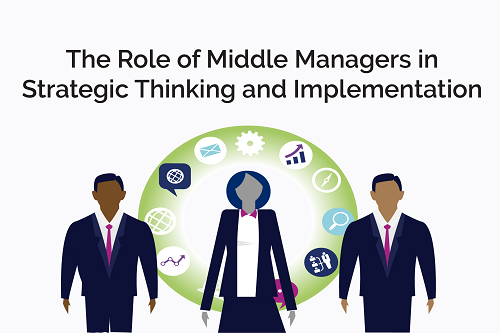
The Role of Middle Managers in Strategic Thinking and Implementation
The success of the organization is dependent upon the human capital element of your organizational capacity.

The success of the organization is dependent upon the human capital element of your organizational capacity.

I used to work on a research team for a company that produced an operational risk software product. I always found it interesting how different members of the same team answered an important question: what do you do?
Here is the way Person A and Person B responded:
Person A: We do research on the internet and enter data points into an operational risk database.
Person B: We help banks understand operational risk and how much related capital they were required to reserve by providing an analytical software solution that models operational risk in the global market.
Technically both answers were correct. For the data model to be statistically significant, the product needed a certain number of data points, and our research team’s job was to research and categorize examples of operational loss in order to populate the database and make the model work. And yet, somehow Person A’s answer was always unsatisfying for some people.
It might be tempting to say that Person B was simply exaggerating the importance of their work by describing it in terms of the mission of the product line, but I think that misses an important point about the value of thinking strategically no matter what your position with the organization is. Person A was simply describing our job. Person B was describing how we created value. Different ways of describing our work was actually a window into the strategic thinking style of the team members.
From Daniel Pink to Simon Sinek and others, much has been said and written about how people are more motivated and productive when they understand the larger context for their work. Understanding why they are doing the work is profoundly important for creative professionals to feel a sense of engagement. Helping employees transition from narrowly thinking about what they do to more broadly thinking about what they are trying to accomplish can improve organizational performance in a number of ways.
The good news is that strategic thinking is a teachable skill. In our BSC Certification courses, we begin by teaching the basic semantics of strategy. At first, students mechanically append or replace the “task” language that most are comfortable with (we need to develop a new service by milestone x) with language that reflects a higher level objective (we want to improve the customer experience; the development of a new services is one option for accomplishing that). Over time, mechanical semantics evolve into an instinct for intuitively thinking about the strategic context. As students change the way they think about strategy and action, critical thinking skills improve as well (e.g. if we are trying to improve the customer experience, is a new service really the best way to do it?). The transition for many teams from always focusing on tactics and actions to always starting with the big picture and working down can be quite profound.
For more about how to improve strategic thinking in your organization, see our Balanced Scorecard Certification Program or The Institute Way: Simplify Strategic Planning and Management with the Balanced Scorecard.

I had a distressing phone conversation earlier this week. A former client called to say they were at a decision-point. They were trying to decide if they wanted to keep using their balanced scorecard system or not. He went on to say, “to be quite honest, the scorecard really isn’t driving the organization. It feels more like ‘busy work’…it leaves a bad taste in our mouths.” 
“In fact,” he continued, “our project management discipline is clearly what is strategically guiding the organization while the balanced scorecard feels like an anchor weighing us down. It used to be what propelled us forward and kept everyone in alignment. Maybe if we cascade the scorecard, this will help?” I was perplexed. While I’ve diagnosed the root cause and prescribed the solutions for a lot of “broken” scorecard systems, this was the first time I’d heard of project management being “more strategic” than the strategic management system that drives it.
The next day, I joined the client executive team on a web conference. We walked through an overview of an integrated scorecard system – reviewing the 14 components of a fully integrated system. As we talked, some of the team members began remembering back to when they built the original scorecard and recalled how the underlying strategic elements were built – how they brought in board members and stakeholders to inform and set strategic direction. But most importantly, they began to remember when it was built.
This client is a healthcare organization and they built their original scorecard during the last presidential election cycle – at a time when there was political uncertainty. The environment was so uncertain that one of their strategic themes was “Readiness for Public Policy Changes” which meant that their resultant strategic scorecard was designed to prepare them for whichever way the political winds eventually blew. And that scorecard was appropriate for the times.
But their environment has since changed…significantly! In the past year or so, the Affordable Care Act now drives all action and projects at this organization. This massive shift in their strategic environment happened to coincide with the implementation of a robust project management system in which the portfolio is aligned to the tenants of Triple Aim. That’s when the room went silent. As I strained to hear across the phone line, I began to hear murmurs as one after another team member came to the same diagnosis. Their environment had changed and they had shifted strategic directions without updating their strategy / strategic balanced scorecard. Their strategic scorecard was outdated….expired! Their sense that their old scorecard was anchoring them in the past and was at odds with the new implied direction of the organization was absolutely correct.
They had stumbled into the classic “Set It and Forget It” mistake. Their project management discipline (which is critical to strategy execution) appeared to be “more strategic” because it was more aligned with their true strategy than was the rest of their strategic management system. Due to some key team member turnover, they had forgotten their entire system needs to go through a regular strategic evaluation cycle! Scorecards do not have indefinites shelf lives….they are dynamic systems designed to allow an organization to shift directions, as needed. The team is now in the process of updating their entire strategic management system to reflect their current reality. And as part of this update process, they will ensure that their current strategic direction is chosen, not implied. Only then can they be sure that their current portfolio of projects is truly aligned for maximum strategic impact.
Does your scorecard have a funky smell? For more examples of Scorecard Challenges and Solutions, we invite you to read “The Institute Way: Simply Strategic Planning & Management with the Balanced Scorecard.”
We also invite you to join the conversation at our Linked In group: www.theInstitutePress.com/group